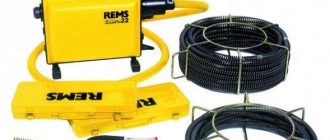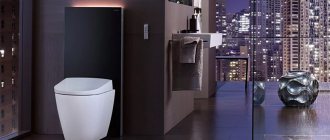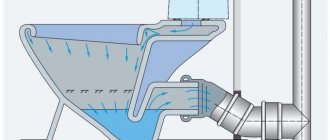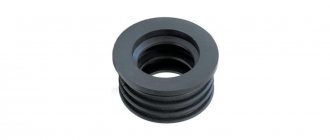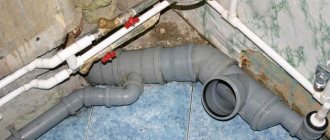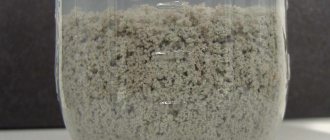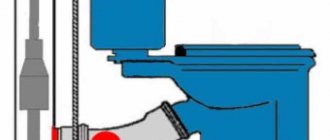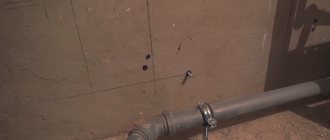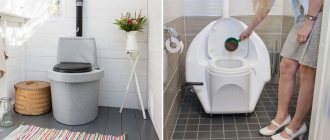The screen under the bathtub is a relatively simple but practical design.
Such a decorative product consists of several basic elements, most often represented by a frame, as well as panels and doors, sometimes shelves and drawers.
This design is quite easy to make yourself.
Bath screen design
Standard screens may differ not only in the materials used in manufacturing and appearance, but also in design characteristics, sizes and shapes. Regardless of the basic parameters, the design of a simple screen consists of a frame frame or a pair of aluminum, steel and plastic guides. Solid or composite panels can be fixed to the wall.
Typical design features:
- screen panels can have a combined appearance;
- the length of a standard product for an acrylic bathtub varies between 150-170 cm with a height of about half a meter;
- depending on the size of the font, the design is adjusted using the legs and the adjusting screw that comes with the screen;
- for universal models with panel curtains in an aluminum frame structure, the possibility of convenient adjustment to the desired size is provided;
- in stationary screen structures on a frame frame that have a static size, adjustment is not provided;
- Frameless screens are used on open end areas and, as a rule, are installed in the main guides.
It should be noted that designs of non-standard end or semicircular type are inconvenient for installation under traditional cast iron bathtubs.
A screen product for a bathtub is a fairly simple design that occupies the space from the floor to the edge of the plumbing fixture, is located on the side and covers pipeline and underwater elements.
Varieties
Screen products can be hinged and sliding, as well as continuous or stationary.
There are no universal solutions in the design and materials used for designing a screen for a font, so the choice of the type of such a practical decorative product for the bathroom is carried out strictly individually.
Optimization of space in the bathroom is achieved by installing a special screen equipped with shelves and cabinets, the design of which can be retractable or sliding.
Solid (solid) models
A solid or solid type screen design is the simplest and most obvious solution for a bathroom of any size. The cladding of such a product is usually carried out in the style of decorative finishing of the entire room, which allows you to effectively complement the interior design.
The most noticeable disadvantages of blind models include the lack of access to systems and the inability to rationally use the space under the bathroom.
Bath screen MDF 1.7m coupe white
Repair and maintenance work will require dismantling the screen.
Sliding models (compartment screens)
The most economical and practical solution. Sliding doors slide along a pair of installed horizontal guides, so they do not take up any space during the opening process.
Self-installation of such a structure is not difficult, and if desired, you can easily and quickly dismantle it.
The sliding screen can be installed on any type and size of bathtub
Sliding models are presented in a wide range and differ not only in size, but also in color and design. Some models are equipped with shelves convenient for storing household chemicals and various accessories.
Models with doors
Models of screen products with hinged doors allow the bath to become a unique part of a traditional furniture set. This option will be preferable if there are cabinets and pencil cases, cabinets, shelves and other pieces of furniture in the bathroom, made in a single stylistic solution. In this case, the design of the screen must be in harmony with the color scheme of the entire headset.
Closing the space under the bathroom
Kinds
Currently, bathroom screens can be purchased in every specialty store. By type of construction they differ in:
- Solid. This type of screen for a bathroom is always considered the most rational solution due to the simplicity and efficiency of the design. The cladding is carried out with the same material as the entire room, for example, tiles. This allows the screen in the bathroom to look harmonious with the surrounding interior. However, the main disadvantage of this technique is the lack of access to plumbing, as well as the inability to store utility tools, materials and household chemicals under the bathroom. If repairs are necessary, the entire screen will need to be disassembled.
Solid - Sliding. This type of screen for a bathroom is rightfully considered much more practical than its solid counterpart. Its functionality allows you to use the basement space to hide communications and store all the necessary materials, tools, as well as household products used when using the bathroom. The main disadvantage of the sliding option is its not entirely aesthetic appearance.
Sliding
However, the material used during assembly can be completely different:
- mirror;
- PVC panel;
- tongue-and-groove slabs;
- drywall;
- plexiglass;
- acrylic;
- ceramic tile;
- MDF.
Mirror
Such bathroom screens are in steady demand, because a mirror is needed in every room and especially in the shower. A mirror screen under the bath will visually expand the space and also add play of light. These elements can be placed at different angles or under unusual light, for example, with neon inserts. Real mirrors are cut out to fit the mirror screen under the bathroom, which makes the design very impressive.
Mirror screen
However, due to the fragility of glass, from a practical point of view, this option looks very risky. If you have small children, elderly family members or pets at home. In addition, manufacturers offer their customers plexiglass screens for the bathroom with mirror coating. This design is less susceptible to mirror debris. A glass screen for a bathroom can become a highlight of your interior; moreover, it is not afraid of moisture and is easy to clean.
PVC panels
Installing a PVC panel under a bathroom yourself requires certain requirements, for example, the availability of the necessary tools. However, after installing the screen under the bathtub, this design can become a full-fledged object of the entire interior of the shower room. A wide range of bathroom screens allows you to choose a stylish design in any color scheme, pattern or image on the material.
Currently, color bath screens are in good demand, as they have an attractive appearance. In addition, when using screens made of PVC panels under the bathroom, no problems arise; the doors open and close freely. In addition, in the absence of mechanical impact on the structure, the screen for the bathroom will last for many years.
Tongue-and-groove slabs
Building blocks that are fastened together using tongue-and-groove fastenings are tongue-and-groove slabs. They have an attractive appearance, which is very important for a bathroom screen. It is recommended to tile them with ceramics, as it creates a certain style that goes well with the entire shower room. However, you will have to slightly sacrifice the height of the structure for the small indentation needed when installing the tiles.
Tongue-and-groove slabs
The area for the future screen under the bathroom must be carefully primed, after which the necessary markings are applied to the floor and wall. It is done with a margin of 5 mm deep into the structure. Then the screen itself is laid out in the bathroom using tiles, connecting the products together with a special solution, for example, tile adhesive or gypsum plaster. The bath screen is ready!
Drywall
This material is considered the most affordable and is well suited for use as a bathroom screen. Its advantages are lightness, affordable price, high installation speed. You can even assemble a plasterboard screen for a bathtub yourself. Usually a solid structure is made from it, after which it is covered with tiles.
Drywall screen
Initially, the general frame is assembled from 40x40 mm timber, fasteners and metal corners are installed. Then the necessary markings are applied to the walls and floor covering for the future location of the screen under the bathroom. Usually these are parallel sections made with an offset in depth of 25 mm.
We fasten the vertical slats at the outer corners, focusing on the markings, and then fasten the horizontal slats at the bottom and top. In total, you will need 2 such structures for the narrow part and 1 for the wide part. We drill a couple of holes in the wall and attach the slats there with screws, and then fasten the resulting structure. It is possible to install lower slats to the floor covering to improve stability.
In fact, the screen for the bathtub is ready, but the front panel still needs to be made. The resulting dimensions should be measured, i.e. height and width of the structure. Then it is necessary to cut the required parts from a sheet of moisture-resistant plasterboard and equip them with a special latch or hanging hinges. This will be the door under the screen under the bathroom. All that remains is to establish the dimensions of the hole, decide on its location and secure everything with screws.
Plexiglass
Also a sliding screen for the bathtub, made of organic glass or plexiglass. It is considered a very stylish solution for a shower room, as it is distinguished by its presentable appearance and aesthetics. In terms of its performance qualities, it is perfect for the bathroom, however, it has its drawbacks. For example, a plexiglass screen for a bathtub is characterized by insufficient strength.
Plexiglass
Other properties more than cover the weaknesses of the material. It is easy to maintain, is not afraid of high humidity, and will last for many years. The screen for a bathtub made of organic glass can be made in various colors or structures. Therefore, its selection is very simple, as it is suitable for the design of any room. In addition, bathroom screens have a matte, transparent and even mirror texture.
Ceramics
A ceramic bath screen is a fairly common way to decorate a bathroom. The appearance of such a screen in the bathroom can significantly improve the room, bringing neatness and completeness of style to it. Ceramic tiles are also often used when finishing a plasterboard or tongue-and-groove screen under a bathroom. Do-it-yourself installation is quite simple.
Ceramics
It is necessary to measure the dimensions, determine the width and height of the structure. Then begin the process of laying tiles from the upper left corner horizontally. Each ceramic element must be lubricated with tile adhesive or liquid nail solution. The screen under the bathtub is leveled with special crosses, which are inserted into the gaps between the ceramics. Sliding frames can be equipped with additional doors, so tiles are applied to them, after which the seams are grouted.
Acrylic
The acrylic bathtub screen is one of the popular models. Acrylic bathtubs usually come complete with a screen. They are made using plastic, made in the form of panels with an acrylic layer applied. These examples of bathroom screens are individually adjusted to the dimensions of the shower. Thus, finding a universal acrylic screen for a bathroom will be very problematic.
Acrylic screen
Worth knowing! Acrylic bathroom screens are reasonably priced, light in weight, look attractive, and are durable. However, it will not be easy to install the selected screen model in the bathroom, since it has a specific fastening mechanism.
Sliding
The sliding bath screen itself has very extensive functionality. It allows you to hide from prying eyes a secret place intended for storing various materials, tools or household products. In addition, a sliding screen for the bathroom becomes indispensable at the moment when you need to fix the plumbing or other hard-to-reach communications.
In this case, there is no need to dismantle the covering; just move the sliding screen door under the bathtub. In addition, housewives who love cleanliness will appreciate how convenient it has become to care for the shower room. Sweeping out the trash or cleaning the area under the bathtub screen just got a whole lot easier.
Installation of the structure is carried out quickly, even with your own hands. Specialized stores always stock a wide range of bathroom screen models. Separately, it is worth noting that the height of the screen under the bathroom is independently adjustable.
Note! Often, sliding screens for the bathroom are made of plastic material, however, there are other options.
MDF
MDF bathroom screens are distinguished by a natural wood pattern. These models will suit the classic design, as well as when choosing a rustic or environmental theme. A variety of shades makes it possible to choose any interior items to match the screen for the bathroom. At specialized outlets you can select various MDF screens for your bathroom with a solid or sliding design. In any case, it will look stylish, expensive and luxurious.
MDF screen
When purchasing MDF screens for a bathtub, you need to know that the models sold are suitable only for standard bathtubs. In addition, MDF is not a moisture-resistant material, which is why after a few years under the bathroom screen there will be a favorable environment for the development of microorganisms, and the product itself will deform and swell and can only be disposed of. To prevent this from happening, it is better to buy a bathtub screen treated with a special water-repellent compound.
Material of manufacture
A variety of materials are used to make a screen for a bathtub, so when choosing such a product, not only all the advantages, but also the disadvantages of the purchased design should be taken into account.
| Type of material | pros | Minuses |
| Aluminum | Affordable price, strength and durability, wear resistance, light weight, attractive texture in a minimalist style, wide range of colors. | The need to provide surfaces with proper care. |
| High strength plastics | Practicality, sufficient strength, ease and simplicity of self-installation, a wide selection of colors and textures, long service life. | The need to provide surfaces with proper care. |
| MDF panels | Quite a wide selection of colors and shades, laminated surface, ease of maintenance, variety of options when choosing designs. | Very limited service life, risk of deformation when used in rooms with poor ventilation. |
| Ceramics | Affordability and aesthetics, the possibility of self-production. | The plasterboard base for ceramics is not reliable and durable enough. |
| Wood | Affordable price; Possibility of use in monolithic, sliding or swing-type structures. | Quite a limited service life, risk of deformation during operation, the need for treatment with special compounds. |
| Plexiglass | An almost endless range of colors, ease of processing, very aesthetic appearance, high strength and durability. | It scratches easily, which is why it requires special gentle care. |
| Acrylic | Excellent moisture resistance, good appearance, easy maintenance, high ductility and good flexibility. | Inexpensive models may contain toxic volatile components and also lack strength. |
Screens made of MDF sheets and mirrors
MDF screens for bathtubs are most often used in classic room design, as they have a wood pattern. A wide range of colors and textures allows you to choose a product that will suit any interior. MDF shielding looks stylish and expensive, which often attracts buyers. However, when purchasing such a screen, you need to pay attention to two important points:
- products made from this material are only suitable for standard, rectangular bathtubs;
- MDF screens are made by compressing sawdust, so they are not resistant to moisture. In order to solve this problem, it is necessary to choose a moisture-resistant material that is equipped with a protective film.
Plumbing stores have a large selection of MDF screens of various designs - solid and sliding
The demand for mirrored models is quite simple to explain. Most modern bathrooms are small in size, and a mirror surface can visually increase the space of a room. Such panels also add play of light. They can be mounted at different angles, and also equipped with special lighting (for example, neon).
In any case, the mirror screen looks very impressive. However, such panels are not without their drawbacks, including fragility and difficult maintenance. Drops of water and stains on a mirror surface are much more noticeable than on any other surface, so you will have to wipe them quite often.
You can make a screen from MDF with your own hands, which will be exactly the same as the furniture in the bathroom
Dimensions and height of the bath screen
The optimal dimensions of the screen structure for a specific font in a plumbing room make it possible to easily solve not only design, but also practical problems presented by:
- rational organization of the plumbing space;
- thoughtful use of the free space under the font;
- systematization of storage of household chemicals;
- original and complete interior design;
- providing the pipeline under the bathroom with reliable protection from negative external influences.
The space under the bathroom can be used for household needs
Standard side models are characterized by lengths ranging from 150-180 cm, heights of 50, 55 and 56 cm, but if necessary, you can purchase or order products of non-standard sizes.
DIY making
The easiest to make yourself and affordable is a static screen structure based on plasterboard sheets fixed with a wooden frame base. For manufacturing, you will need to purchase 40x40 mm wooden blocks, standard fasteners and metal corners.
Blanks made in accordance with preliminary measurements are represented by slats:
- to connect the floor to the corners of the bath - four pieces;
- equal in width to the inner line of the font minus 8 mm - two pieces;
- equal in length to the inner line of the font minus 12 mm - two pieces.
Homemade bath screens
If necessary, additional supports are prepared, which are important for the design of a font that is too long.
The supporting frame can also be made of a metal profile, which will make the screen structure more reliable and durable.
Installation
The technology for self-installation of a manufactured plasterboard screen under a bathtub is very simple:
- arrange the vertical slats in accordance with the outer corners of the font, and taking into account the markings made;
- secure horizontal support elements between the vertical slats;
- drill a couple of holes in the slats adjacent to the wall, and then secure them with screws;
- cut out elements from moisture-resistant plasterboard sheets with an overlap of 5 mm in width, providing a door for access to the pipeline system under the font;
- attach hinges and a latch to the door, then securely fix all elements to the frame base.
After the installed screen structure has been checked for stability and strength, you can perform final decorative painting, finishing with a special self-adhesive film or other facing materials.
MDF screens
Screen for bathtub sliding MDF Still from Alavann
They are made from wood board with a film coating.
Why choose MDF panels:
- Easy to maintain - all dirt is easily washed off.
- Variety of designs: you can choose not only a front version, but also an end version, which is indispensable in situations where the bathtub bowl is open on both sides and is not installed tightly between the walls. Both sides are firmly attached to the frame and perform their functions perfectly.
- Affordable price.
Their disadvantages include only standard sizes, which in some cases may not coincide with the dimensions of your bathroom.
Simple and cheap: bath curtains. Perhaps the most budget-friendly, but not very convenient solution, used when it is impossible to find a ready-made option for a bathtub of a non-standard shape. Curtains are not very convenient to care for, and perhaps in this case it makes sense to make them to order.
Price
In modern screen structures, the frame is made of a four-chamber PVC profile in accordance with patented technology, and due to the absence of a closed frame, installation of the product is easily carried out in places where the water supply system passes.
The average cost of such products is 1500-2500 rubles.
It is important to remember that ordering an individual sliding screen with special drawers and shelves for a standard bathroom is impractical, since such roll-out elements can be purchased separately.
Aluminum frames require fairly frequent touch-ups, but can easily withstand even very heavy panels . Among other things, if the ventilation mode in the bathroom is disrupted, then laminated chipboard and MDF screens should absolutely not be installed.
Advice from professionals
- You should not place bulky furniture in a small bathroom, even if space allows. Are the toilet, sink and bathtub installed compactly? Do you have room for a large closet? Don't buy it. In a small room it will simply look ridiculous. It is better to install a hanging box and a floor cabinet.
- Don't overload the space. Whatever the room (large or small), there is no need to try to place all types of furniture in it at the same time (from wall shelves to a pencil case). Limit yourself to 2-3 items.
- For non-standard bathroom sizes, it is better to use the service of custom furniture production. You do not have to adjust interior items to the dimensions of the room, unfold toilets, change the location of the bathtub and other plumbing fixtures.
♥Don't settle for just one solution. Compare, plan, experiment. This will definitely allow you to find furniture that will fit effectively into a specific room.♥
